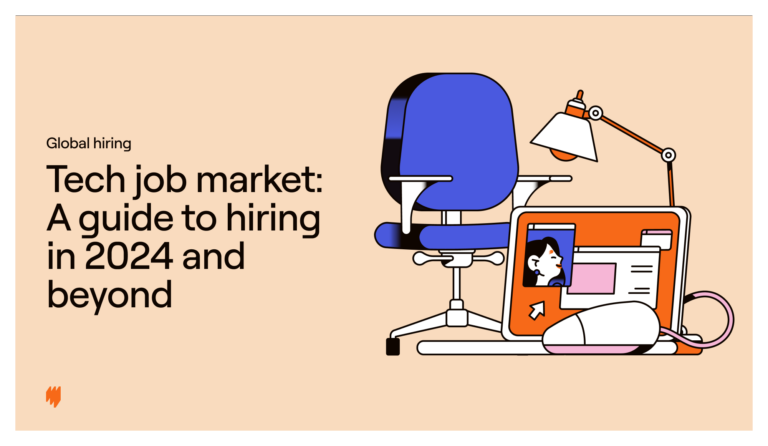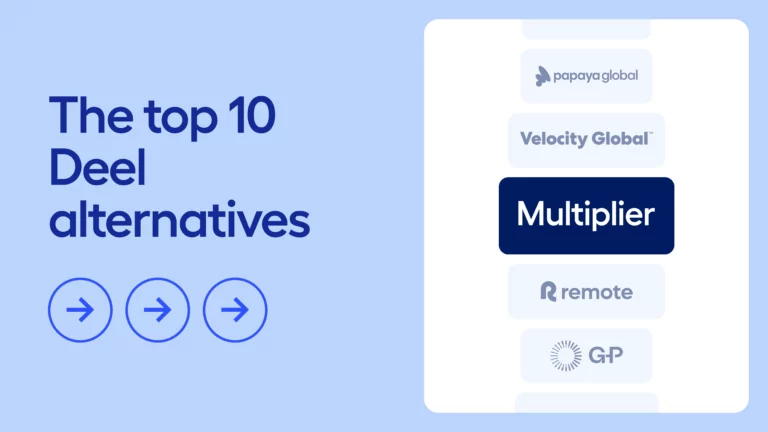With skills-based hiring, you can pinpoint the people with the abilities your organization needs to grow and adapt to market changes.
But how can you find an objective way to measure your applicants’ core competencies? And how can you extend this approach across the globe as local talent pools dwindle?
These are some of the questions we explore in this complete guide to skills-based hiring with a global focus. You’ll uncover unique insights from Rich Wilson, CEO of the AI-powered talent platform, Gigged.AI, and Alycia Damp PhD, Head of Applied Behavioral Science at HireGuide. You’ll also discover a tool that makes your approach to skills-based hiring more seamless.
What is skills-based hiring?
Skills-based hiring is where companies assess candidates based on their abilities rather than their qualifications, education, years of experience, or location.
“Skills” in this context refers to both technical competencies (“hard skills”) and personal attributes (“soft skills”). For this reason, skills-based hiring is typically carried out through a combination of practical assessments and psychometric tests.
In skills-based hiring, the focus shifts away from factors that often don’t actually correlate with on-the-job performance and, as Wilson describes, “zeros in on what really matters: a candidate’s ability to deliver results.” This means less of a focus on degrees, where they are not essential, and fewer requirements for candidates to have trodden a carefully defined career path.
Taking skills-based hiring to its logical conclusion, the approach should extend to geography. Companies need to be able to recruit the most skilled workers, wherever they are in the world.
Why is skills-based hiring important?
As Damp identifies, skills-based hiring allows companies to resolve three major challenges they face today: the economic challenge presented by the talent crunch, the social importance of fair representation and inclusion, and the legal issue presented by employment discrimination risks. It also allows businesses to stay agile, hiring faster and making better decisions for the future.
In this section, we explore these four benefits of skills-based hiring in more depth.
Beating the talent crunch
Across sectors, businesses are struggling to find the skills they need. But by expanding their talent pool with a focus on hiring for skills over educational requirements or location, companies can resolve this issue. Here’s how.
Rethinking educational requirements
This talent gap is caused in part by a rapidly aging workforce. With more experienced employees retiring, companies are forced to consider younger workers. And since many of this demographic are reluctant to complete extensive educational requirements, companies can attract more talent by focusing on skill assessments.
To take an example, many US companies are struggling with major accounting shortages — in part, because fewer young people are interested or able to take the National Certified Public Accountant (CPA) exam. By hiring for skills, companies are able to hire talent who may not have a CPA license but still possess strong accounting abilities.
Expanding the talent pool
By extending their skills-based hiring approach globally, companies can fill talent gaps even faster. As Wilson describes, “Prioritising skills over location means businesses can access a vast, global talent pool and reduce the time and cost associated with traditional hiring and training processes.”
How does this look? Put it this way: While you might not be able to find an employee in a nearby town with X qualification for a few months, someone with the exact same skillset could be sat in another country looking for a role like yours.
In the case of the accountant shortage, increasing numbers of companies are extending their search for talent globally, filling gaps, diversifying perspectives, and saving money at the same time.
Improving inclusivity
By introducing more objectivity into the hiring process, skills-based hiring allows companies to evaluate candidates more fairly. Rather than being influenced by the prestige of a particular degree or the unconscious biases associated with particular demographics, companies can find the real best fit for a role.
And, in taking away the requirements associated with more traditional or privileged pathways, skills-based hiring opens the door for a more diverse range of applicants. “It enables the hiring of people who come from historically underrepresented groups,” Alycia Damp explains.
This approach is the ideal way to ensure you have the range of perspectives necessary in your organization to drive change and innovation while reducing employment discrimination risks.
Boosting business agility
Skills-based hiring has been shown to be more efficient than traditional hiring methods. And by increasing the pool of talent you have to pick from, it can, as Wilson describes, “support you to quickly adapt to market shifts.”
The time savings are clear… You don’t have to spend as long searching for someone in the same location as you or with a certain qualification. You don’t need to read through dozens of applications, many of which contain errors and white lies and you can avoid long question-based interviews that eat into your team’s capacity.
What’s more, you won’t need to redo interviews when you don’t find the right fit. As Damp says, “Decades of behavioral science research show that skills-based hiring helps you make more accurate hiring decisions.”
The challenges of skills-based hiring
Ready to start focusing more on skills in your hiring processes? Here are some common pitfalls to be aware of.
Internal resistance
Skills-based hiring is still a relatively new idea and, despite public commitments to introducing new hiring methods, companies are still being held back by the uncertainty of hiring managers and other stakeholders. Some of the common misconceptions that lead to internal resistance include:
- The idea that skills-based hiring creates a worse candidate experience due to the time commitment skills tests require.
- Concerns that skills-based hiring will be more expensive to implement.
- Confusion around how to accurately test for the required skills.
Lack of clarity around skills
As Matt Doucette Director of Technical Recruitment at Deliveroo described when we spoke to him about the tech job market, “One of the biggest reasons why companies can’t find the skills they need is that they don’t know exactly what those skills are.”
While the immediate skills employees need are obvious, it can be hard to define their secondary skill requirements. For example, a software developer’s primary skill requirement may be coding, but if they frequently work with cross-functional teams, strong communication and collaboration skills become equally important.
As new technologies emerge and companies adapt, the challenge of highlighting skills becomes even more crucial.
Minimizing subjectivity
Though skills-based hiring is a more objective method than traditional hiring techniques, it is not without bias unless implemented perfectly. Without a clear, data-driven benchmark for skills, subjectivity can creep into hiring practices.
How to hire for skills, globally
In this section, we cover the strategies, best practices, and tools you should implement to optimize skills-based hiring processes wherever you are recruiting.
Start small
“Skill-based hiring lends itself well to short-term and task-based projects,” Wilson describes. And, until your hiring processes are tight, it’s a great idea to start with positions where you’re seeking highly specialized skills with a quick turnaround.
Taking this approach can also help you get buy-in from senior leadership. You’ll have more time to show how skills-based hiring delivers results.
Build a skills-first culture
Skills-based hiring requires a cultural shift. As Damp says, “It’s important to keep in mind that it’s not just HR that needs to change for skills-based hiring to work.”
This means it’s crucial that stakeholders, managers, and anyone involved with employee selection is educated on the benefits of skills-based hiring.
To do so, Damp suggests that you “pilot the new approach with a few hiring managers, track metrics, and gather feedback.” Developing a refined process and key messaging can help accelerate the shift to a skills-first model.
Pinpoint your needs and focus your job ads
Before advertising a new role, you need to forecast all the skills you’ll need at both the team and organizational levels. This is no small task, but it can help you focus your priorities and identify gaps in your team that can’t be filled with upskilling or reskilling in the coming years.
Then, in your job ads, Damp recommends “differentiating between skills that are critical and coachable and dropping the coachable ones.” A skills-based hiring approach will place only core skills front and center, removing education stipulations unless required, and cutting a requirement for X number of years’ experience.
Ensure objectivity in your assessments
According to Wilson, real-world tasks, and practical tests are some of the best ways to measure a candidate’s skills. And whichever method you choose, the key is to make your skills assessments as objective and unbiased as possible. For example, you might, as Damp suggests, “use behavioral or situational interview questions, ensure each question is mapped to a specific skill, and ask all candidates the same questions.”
It’s also important to implement skills tests as the first stage in your interview process to prevent biases from creeping in beforehand. Rather than recruiters making decisions on which candidates should undertake skills tests, introducing a higher element of subjectivity, a skills-first approach provides you with a bank of data to utilize.
You can also look to artificial intelligence tools to provide anonymity, objectivity, and data throughout the skills-based talent acquisition process. “AI-driven platforms can analyze candidate data and match skills with job requirements effectively and efficiently,” Wilson explains.
Use an EOR to make global hiring easy
To truly level the playing field for candidates and recruit the right skills for your company, you need to be able to hire from anywhere. As Wilson describes, “This diversity brings new perspectives and ideas, driving innovation and helping solve problems in ways that wouldn’t be possible with a local-only approach.”
The challenge is that, between compliance issues and high costs, global hiring can be complicated and stressful… And that’s where an Employer of Record comes in.
By using an EOR, you can hire, onboard, and manage staff without needing to set up a local entity. In one platform, Multiplier handles global payroll, localized benefits, contract creation, and more. This means you don’t need to worry about staying compliant with local laws or onboarding new employees. You can simply focus on hiring the skills you need.
Want to learn more? Speak with one of our team.

Beth Longman
Content Writer
Beth Longman is a content writer at Multiplier. With extensive experience in SaaS, she combines data with storytelling to create engaging pieces.





